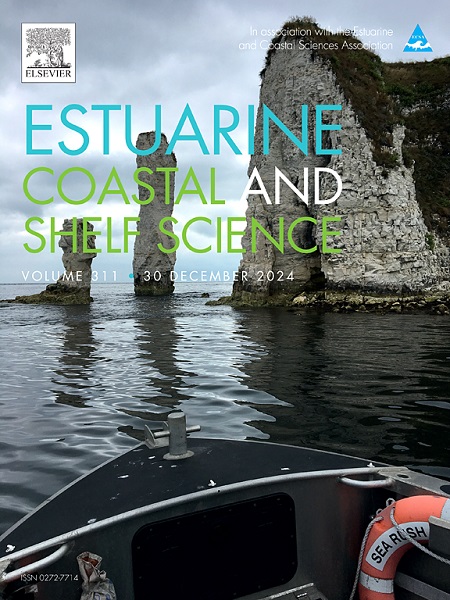北亚得里亚海定点观测系统叶绿素荧光、藻华及其驱动因素的年代际分析
IF 2.6
3区 地球科学
Q1 MARINE & FRESHWATER BIOLOGY
引用次数: 0
摘要
2012年8月至2022年12月,在E1气象海洋浮标上进行了叶绿素荧光(ChlF)的连续光学测量,该浮标是位于北亚得里亚海艾米利亚-罗马涅海岸(意大利,地中海)的一个固定观测系统。使用WET Labs®ECO三重态荧光传感器,共69,705小时ChlF观测揭示了海面叶绿素浓度的显著季节性和年际变化。ChlF浓度范围为低于检测限,最高日平均值为41 μg/L,季节性高峰为春季(4 - 6月)和冬季(1 - 3月)。由于基于净增长率和其他参数的藻华自动检测程序,有可能确定十年期间的40次藻华事件。主成分分析(PCA)强调了温度、溶解氧、浊度、盐度、风速等关键环境因子以及营养物质运输和淡水输入等过程对Chl变异的影响。季节模式是主要驱动因素:春季华主要受温度、盐度和溶解氧的影响,夏季典型的分层条件和零星的华事件,而秋冬华更多地受风速和浊度的影响,这促进了营养物质的再分配和混合。此外,对藻华的分析确定了两种不同的季节性模式:单峰华,主要发生在春季,多峰华,典型的秋季和冬季,每一种都由特征环境条件决定,形成开始,发展和持续时间。这些发现强调了长期数据系列在了解沿海海洋生态系统和评估驱动藻华事件的环境因素方面的重要作用。本文章由计算机程序翻译,如有差异,请以英文原文为准。

Decadal analysis of chlorophyll fluorescence, algal blooms and driving factors from a fixed-point observing system in the Northern Adriatic Sea
From August 2012 to December 2022, continuous optical measurements of Chlorophyll Fluorescence (ChlF) were conducted at the E1 meteo-oceanographic buoy, a fixed-point observing system located off the Emilia-Romagna coast in the Northern Adriatic Sea (Italy, Mediterranean Sea). Using a WET Labs® ECO Triplet fluorescence sensor, a total of 69,705 hourly ChlF observations revealed significant seasonal and interannual variations in chlorophyll concentrations at the sea surface. ChlF concentrations ranged from below detection limits to a maximum daily average of 41 μg/L, with seasonal peaks during spring (April–June) and winter (January–March). Thanks to an automated detection procedure for algal bloom based on net growth rates and other parameters, it was possible to identify 40 bloom events over the ten years period. Principal Component Analysis (PCA) highlighted the influence of key environmental factors such as temperature, dissolved oxygen, turbidity, salinity, wind speed, as well as processes like nutrient transport and freshwater inputs, on Chl variability. Seasonal patterns emerged as primary drivers: spring blooms were dominated by temperature, salinity, and dissolved oxygen, summer typically featuresstratified conditions with sporadic bloom events, while autumn and winter blooms are more influenced by wind speed and turbidity, which promote nutrient redistribution and mixing. Moreover, the analysis of algal blooms identified two distinct seasonal patterns: Single – Peak blooms, predominant in spring, and Multi – Peak blooms, typical of autumn and winter, each defined by characteristic environmental conditions shaping onset, progression, and duration. These findings highlight the essential role of long-term data series in understanding coastal marine ecosystems and assessing the environmental factors driving algal bloom events.
求助全文
通过发布文献求助,成功后即可免费获取论文全文。
去求助
来源期刊
CiteScore
5.60
自引率
7.10%
发文量
374
审稿时长
9 months
期刊介绍:
Estuarine, Coastal and Shelf Science is an international multidisciplinary journal devoted to the analysis of saline water phenomena ranging from the outer edge of the continental shelf to the upper limits of the tidal zone. The journal provides a unique forum, unifying the multidisciplinary approaches to the study of the oceanography of estuaries, coastal zones, and continental shelf seas. It features original research papers, review papers and short communications treating such disciplines as zoology, botany, geology, sedimentology, physical oceanography.

 求助内容:
求助内容: 应助结果提醒方式:
应助结果提醒方式:


